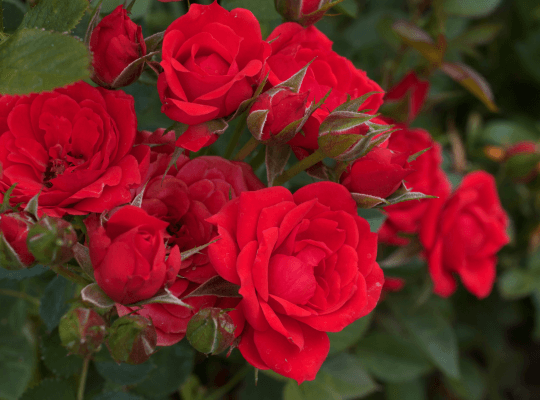Red color varieties:
Grand Gala: It has deep burgundy red color flowers. The flowers have velvety petals and vertical stem which has 60-100cm height.
Fast red, Passion, Grand Prix and Bordo are the red varieties of rose.
Yellow color varities:
Almiyar Gold, Paipiliyan and Gold Stripe are the yellow varieties of rose.
White color varieties:
Biyaanka, Virginia and Hollywood are the white varieties of rose.
Pink color varieties:
Sonia, Carlight and Noblas are the pink varieties of rose.
Bicoloured varieties:
Confetti is the bilcolored variety of rose.
Other state varieties:
Rose Classification
It consists of three main groups 1) species 2) old garden and 3) Modern rose.
Species roses: It also called as wild rose. These types of flowers consist of five petals with bright colors. They last for long time in winter.
Example: Rosa rugose: Native of Japan. These are hardy in nature. Flowers are extremely scented with wrinkled leather type leaves. They grow in dense, thick shrub. Avoid use of chemical spray as it shed its all leaves on spraying.
Banksiae: Also known as lady bank and is native of china. Flowers are small, scented and having violet color. Flower comes in small clusters.
Eglanteria: Scented flower with single petals.
Moyesh: Native of china bears red rose.
Multiflora: Native of Asia. Flowers are strongly honey scented with white color petals.
Musk, Setigera, Sempervirens, Soulieana
Old Garden Rose: These types of flowers are more attractive and scented. Suited to warm climate and sustain well in winter. These are easy to grow, disease resistant and sustain well in winter. They grow in shrub also some grow like vine. Flowers are colorful but white and pastel color is most popular. This group consists of China roses, Tea roses, Moss Rosses, Damask roses, Bourbon Roses, Alba, Ayrshire, Gallica, Hybrid Perpetual, Portland, Ramblers, Noisette etc.
Alba: Light pink to white color flowers.
Bourbon: Light pink to deep pinkish red flowers.
Boursault: climbing type shrub. Flowers are purplish red color.
Centifolia: Also known as cabbage rose as flower is full, round. They are found in color range of white to pink.
Damask: Flowers are found in deep pink to white shades.
Hybrid Perpetual: Highly scented with large flowers, color ranges from pink to red.
Macrantha: Light pink to white color blossom. Flowers come once in late spring.
Moss: Shrub like variety and flowers comes in variety of color.
Noisette: Scented flowers with shades of pink.
Modern Roses: These are most popular and obtain from cross breeding of hybrid tea and primrose. Flowers are of various colors, rich and vibrant.
Example: Hybrid tea roses, Floribunda roses, yellow permet rose, Grandiflora Roses, American Pillar, Grandifloras, Albas, Landscape Rose, Centifolia rose , mini flora, Hybrid Musk and Polyantha.
Hybrid tea: These are most popular among modern roses. Plant grows upto 3 to 5 feet and flowers petals are double or semi double. Example: Paradise, Peace, Polarstern, Pristine etc.
Floribunda: Bush type variety having small flowers and even short stem. Flowers are borne in cluster. This variety contains Frisco, kiss, Florence, Jaguar, Impatient, Angel Face, Ivory Fashion.
Shrub Rose: These belong to class of wild species. They are hardy in nature and required little maintenance. These are cross between special rose and bush rose. Flowers come in mass and of large size and colorful but no definite form. Plant grows in shrub. Example: Bonica, Frau Dogmar Hartopp, Abraham Darby, Golden Wings etc.
Climbing rose: These types of roses are having long branches, required support. Requires little pruning. They can grow on wall, fences etc. Flowers are large. Blaze, Don Juan, Dortmund, Climbing Iceberg, Ever blooming climbers, Rambler roses, Trailing roses and large flower climbers are belong to this class.
Miniature Roses: Plant grows up to 2 feet height. Flowers are small, attractive with various range of color. Example: Rainbow\\\\\\\'s End, Red Beauty, Rise \\\\\\\'N\\\\\\\' Shine.
Grandifloras: Plants are tall and grows up to height of 2-3 feet. This type is obtained from cross between Hybrid Teas and Floribundas. Flowers are medium to large and they come in small cluster. Example: Aquarius, Gold Medal, Pink Parfait.
Standard or Tree Rose
Plants grow up to height of 2-3 feet. Flowers are large and full size. These are obtained from budding of bush type varieties.
Flower Carpet: Also known as Groundcover roses. These are pest resistant and can sustain in hard winter. Example: Scarlet, Amber and Pink Supreme.
Commercial Varieties: Pusa Gaurav (Pink varieties), Super Star, Montezuma, Mercedies, Pusa Priya and First Red (red varieties)
Exhibition varieties: First Prize, Eiffel Tower, Pusa Sonia, Red- Christian Dior, Montezuma, Super Star.
Scented varieties: Crimson Glory, La France, Sugandha
Other Varieties: Vivaldi, Sika, Arusumo, Proudland, Summer Fragerance, Gen Vaidya, Kalpana, Mother and Baby, Soller, Night N Day, American Home, Melina, Jogan, Amacia, Montreal, Grandmaster Piece, Pilgrim, MME Teresa Estabing, Golden Jubilee, Papa Pirosa, Chimson Tide, Belami, Elegant Beauty, Pampa, Madelon, Perfect Moment, Rocklea, Hebe Kuborgo, Polarstern, Fulton Mackay, Sweet Surrender, summer dream, Lapdef, Madosh, Dreaming, Pastel Delight, Godavari, Rosenrot, Fragerance Lady, Execiting, Roundalay, City kenda, Jessie Mathews, Portland Thail Blazer, Banco, Dame Décor, Mirandi, Lucy Cromphorn, Jean Gaujard, Krithika, Austin Reed, Tynwald, Leg glow, Emily Post, Alaska Centennial, Bacardy, Touch of Glass, Jayalalitha, Dolly Parton, MME Denise Galloise, Chaitra, Royal Amathyst, Chalis Gold, MME President, Ashwini, Command Performance, Agena, Alinka, Alliance, Alpha, Ariane, Bella Epoque, Bellease, Besancon, Blessings, Blue Monday, Bridal Bush, Bridal Dream, Brinessa, Cabaret, Cacico
Source (Rose Garden, Ooty)











